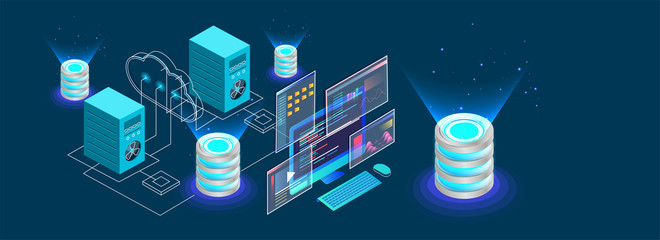Table of Contents
Databases are one of the most important technologies used in web hosting. They store data in a way that can be easily accessed, manipulated, and displayed to viewers. Understanding what databases are and how to use them for web hosting can help you learn more about database options for your website.
Whether you’re familiar with or have never heard of databases, read on to learn more about them and web hosting.
Key takeaways:
- How websites use databases to operate
- What database knowledge is necessary to host a website
- Types of databases and tools used in web hosting
- What you need to know about databases and web hosting
- What types of databases work best for web development
- What relational and non-relational databases are
What You Need To Know About Databases for Web Hosting
If you want to make a website for yourself or your business, you will undoubtedly use a database, a critical component of virtually every type of modern website. But most people do not need to become experts on databases to set up and run a site. It is entirely possible to create a beautiful and functional website without even knowing what a database is.
You can easily create a site because modern content management systems (CMS) and simple-to-use website building tools take care of this. WordPress, for example, can be installed with just a click by your web host.
During that installation, a database is automatically created, which you have to name. Once that is done, most people will never need to interact with the database again.
The WordPress system allows you to easily create blog posts, web pages, and other types of website content. Its tools will automatically place any information that needs to be stored in the database. Since WordPress is used to create more websites than any other tool globally, it is easy to see why most people don’t need a deep knowledge of how databases work.
Should you learn more about databases?
It is helpful if you learn more about databases, but it’s unnecessary unless you plan on controlling every aspect of your website and hosting it by yourself.
For example, if you run into problems with your website and cannot get it to perform as expected, understanding databases may help with troubleshooting. Knowing how databases work is also beneficial if you plan on coding your plug-ins or other custom features for your website.
Databases and Hosting
Almost every web application requires some kind of storage system for its data and content, and the most common type is a database. The many database options fall into two main categories — relational and non-relational. Each option has its own strengths and weaknesses when it comes to web hosting.
The concept of the database might have started before computing, but the first use of a data storage model was invented in the 1960s to allow information to be stored, either for use in memory or for long-term storage outside of memory.
This has since evolved into a plethora of different technologies which all solve the same original problem but in more efficient ways. Today’s database technology fits mostly into two major paradigms (a few other exotic categorizations also exist):
- Relational data, which is mostly structured
- Key-value pairs, also known as non-relational databases (NoSQL), which is mostly unstructured.
Relational databases are mostly known by the model called Structured Query Language (SQL) and focus on recording transactional data. Unstructured data is generally focused on adding flexibility to user data for web applications, and is handled so information can be “mapped” across multiple computers more easily.
Databases and Web Development
The vast majority of websites are backed by databases. Most website owners don’t get to decide what kind of database to use. If you run WordPress, Drupal, or another popular content management or e-commerce system, the database choice is made by the developers.
However, if you are building a custom application, you have a lot of options ranging from simple databases holding for a small blog to complex databases, like those used by Amazon and Facebook.
What database types work best for web development?
The biggest question for modern websites is whether to use relational or unstructured data storage, determined by the developer’s experience. For example, a MongoDB solution might be the best solution, but if a developer is more acquainted with MySQL, it will probably be faster to prototype features in MySQL.
Therefore, NoSQL is structurally designed for storing data without the need to set up relational schemas. NoSQL is not optimized for transactional data, though, and relational databases work far more efficiently in situations where the data structure is always the same.
Once the structured/unstructured question is answered, the remaining decisions for picking a technology should be made based on what operating system, programming language, and root access permissions are available on a selected web host.
Relational databases (SQL)
Relational Database Management Systems (RDBMSes) are the most common type of databases and what comes to mind for most people regarding databases. These are made up of a series of interrelated tables. Each table contains information about a specific type of entity — like people, blog posts, products, transactions, or companies.
And each row in a table represents one instance of that type of thing such as a specific product, with each column representing a specific attribute (e.g. price, name, color). Columns can relate to other tables, for example, when a blog post has a column for author, which refers to a row on a table of authors.
Most relational databases use SQL for commands, so they are referred to as SQL databases, as opposed to NoSQL databases (see below).
There are a lot of relational database systems, but a few of them account for the majority of database deployments, especially on the internet.
- MySQL — One of the most popular database management systems, this powers WordPress, Drupal, and countless other systems. Benefits include excellent documentation, a large user community, and plenty of free tools for modeling and managing databases.
- MariaDB — This is a fully compatible drop-in replacement for MySQL, with improved performance and additional features.
- MS Access — Microsoft’s desktop database system, this is used in Windows to create ad-hoc database-powered applications, or connected to from other Windows platforms like SharePoint or ASP.NET. Access is not typically used as a web applications database, although it could be.
- Microsoft SQL Server (MSSQL) — This is the company’s version of a fully featured SQL database system that works only in Windows.
- PostgreSQL — Powerful and open source RDBMS, the biggest competition to MySQL, is favored by developers who take themselves especially seriously. It is typically considered better at especially complex queries and operations, while MySQL is generally faster during simple queries.
- SQLite — A file-based database utility built as a library that can be added into another application, rather than as an application unto itself. Often used for demos and rapid prototyping, SQLite is built into Ruby on Rails (though other databases are supported).
How a relational database is managed or constructed
A relational database, such as Microsoft SQL, MySQL, or PostgreSQL, can be administered by a set of software tools known as Relational Database Management Software (RDBMS or RDMS).
Often these database tools are installed alongside the database itself, but third-party tools can also be installed sometimes. Once an RDMS is set up, creating the database “schema” becomes an important priority.
Some applications or web applications will manage database architecture for you (such as a CMS) – however, for custom software, the database will need to be set up in an organized, efficient way. There are many different strategies to use, where connecting one table to another is possible by using a “Primary Key” as a “relational” reference column and as a “Foreign Key” in another table.
In such a way, data structures called “schemas” can be set up. These schemas can be charted so that a “data mart” can be planned, where some tables contain “facts” data and other tables contain “dimensions.” SQL statements can reference both fact and dimension tables to create many different data views for various uses from the same underlying information.
NoSQL databases
NoSQL do not follow the normal conventions of relational databases. Often, they have a more flexible data model than RDBMSes and do not enforce data normalization. This can speed up development and make the application’s data organization more accurate to a real-world domain that may not have such strict data definitions.
Depending on the type of data being collected, there can be significant read or write performance benefits that come at the cost of the enforced consistency provided by traditional database systems.
- MongoDB — Probably the most popular NoSQL database, this is document-oriented and stores data in a form of JSON, which makes it highly compatible with JavaScript-based frameworks like Node.js.
- CouchDB — Very similar to MongoDB, this is document-oriented and JSON-based. It uses JavaScript as its query language (Mongo does not) and is highly available. Some of its advantages come at the expense of constant consistency: data propagates through the system in an “Eventual Consistency” model, sothere may occasionally be times when obsolete data is returned by a query.
How non-relational databases are managed or constructed
Databases which use key-value pairs can be easier to install and often don’t require “structure” to use. Key-value data means that every data object has a data name and a data value, which might look like {name: “country,” value: “Canada”}, although many different syntaxes can exist.
Management of NoSQL databases consists of using command line tools, control via a programming language wrapper, or sometimes the use of visual tools in aiding with the MapReduce process.
The MapReduce concept is where all of the challenging work takes place, but results in enormous performance and scalability gains. The “Map” procedure handles information filters while the “Reduce” procedure does summary operations. Together, this makes for quick searches of big data volumes.
Database tools
Having a database management system on your server doesn’t do you very much good if you can’t do anything with it. Some database systems offer built-in tools, but there are a few that need a direct admin panel separate from the application that is using them.
There is no official MySQL Web Interface, but phpMyAdmin is the “unofficial” interface. It allows you to create users, run queries, add or modify tables, and do any other database management task you may need to do.
A similar tool, phpPgAdmin, is available for managing PostgreSQL databases.
Frequently Asked Questions About Databases and Hosting
What are databases used for in web hosting?
How do I host a website with a database?
Do I always need to use a database for a web project?
Not at all. Static websites with no dynamic data will not require any data connection. Or, for some web applications data can be stored directly as a static file in a folder system (such as XML or even directly as HTML).
But having a database will make any project where multiple users can log in and change content regularly far easier to scale.
Using a web server and a data server together through applications is the standard way applications run, and finding the “right” combination of technologies for a project is a process that takes patience and a joy of learning.

